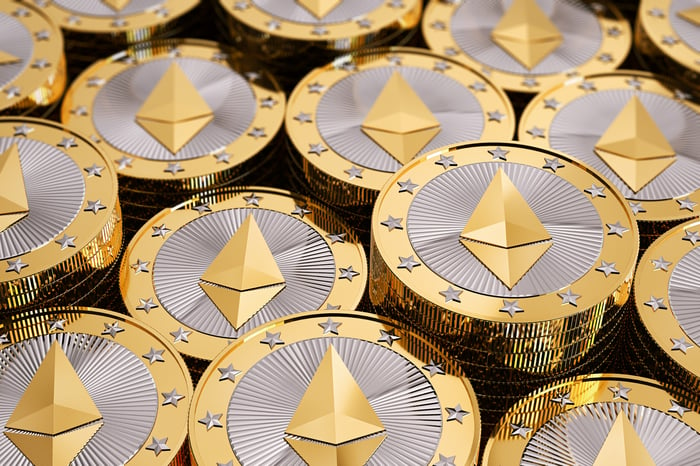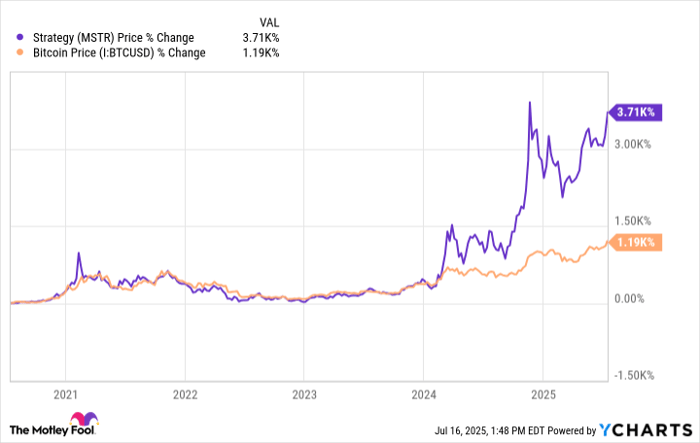Here's What It Would Take to Make $1 Million From Ethereum in 10 Years
Key Points
Ethereum will almost certainly be around in 10 years.
The odds are very good that it will be worth a lot more at that point than it is today.
That doesn't mean its moonshot potential is going to unfold perfectly.
Building a skyscraper starts with a blueprint that looks bold on paper, but it takes more than an architect's sketches for the plan to become a reality. The same applies to the ever-popular dream of turning a modest investment in a cryptocurrency like Ethereum (CRYPTO: ETH) into a seven-figure stake.
Making $1 million with this coin will demand aggressive price appreciation, unwavering discipline, and a healthy tolerance for volatility, not to mention for its roadmap to play out as conceived and then subsequently be well received by the market. Ready to see exactly what it would take?
Where to invest $1,000 right now? Our analyst team just revealed what they believe are the 10 best stocks to buy right now. Learn More »

Image source: Getty Images.
Crunching the numbers
Let's start by envisioning the finish line.
Today, the coin trades at about $3,600. Assume Ethereum coins change hands at $30,000 in mid-2035, which would make for roughly an eightfold gain. That likely would require the network to capture a dominant share of the capital related to decentralized finance (DeFi), tokenized assets, and artificial intelligence (AI)-native blockchain applications. Furthermore, at that price, you would need about 33.4 tokens to crest the $1 million mark.
Buying that much over 10 years at an average price of $5,000 would cost roughly $167,000, or about $1,391 per month.
Most investors cannot afford to allocate that much to one fairly risky investment on a monthly basis, but it might still be possible by siphoning some of the regular flows of capital devoted to buying safer investments, as inadvisable as that may be. Importantly, those numbers shrink a bit if the purchased coins are staked consistently; some validators currently offer staking yields near 4%, and there are some Ethereum exchange-traded funds (ETFs) that now pass on staking rewards to shareholders.
The math here has three pillars.
First, the future price. A $60,000 end price cuts the amount of coins needed in half, and it slashes the monthly purchasing requirement to about $700, which is more manageable. Alternatively, a much lower price would make the entire endeavor financially impractical.
Second is the average purchase price. A nasty bear market could drop your average cost far below today's level, or a melt-up could push it sharply higher.
The third pillar is your own consistency. If you miss a few months of buying, the entire plan starts to wobble fast.
None of those pillars are guaranteed to hold, so investors must treat this projection as a best guess, not a promise.
The assumptions carry a lot of load here
Now that we have a few rough figures pinned down, it's time to vet the assumptions that underlie the chain's prospects for growth.
Ethereum's dominance of the decentralized finance sector looks fairly sturdy today, though not quite as unassailable as it did in 2021, and even less so compared to its strength in 2017. It hosts roughly $80 billion of the DeFi sector's $134 billion in total value locked (TVL), which is good for a market share of about 60%. If that share persists while the sector triples, the network's fee revenue, and by extension its staking rewards, would doubtlessly swell.
Meanwhile, the broader smart contracts market is projected by Research and Markets to grow at a 23% compound annual growth rate (CAGR) through 2029 as more industries automate processes on-chain. It's practically a given that Ethereum will continue to capture a big share of that market, and AI agents that write, audit, and trigger smart contracts could juice growth even further.
Evolving regulation rounds out the bullish case.
A May 29 statement from the Securities and Exchange Commission (SEC) signaled a path for staking to remain legal when offered through registered intermediaries. Coupled with the first wave of ETFs, financial institutions finally have a compliance-friendly way to hold and compound Ethereum, which they are now starting to do.
So, at least on the surface, Ethereum has a decent chance of being able to grow quickly enough to meet the requirements for investors to become millionaires during the next decade, provided they continuously invest some capital on a regular basis.
This is not a slam dunk in any way
Now for the cracks in the mirror.
Rival smart contract chains like Solana offer lower fees and faster transaction speeds. They're also courting developers, both of which could chip away at Ethereum's market share and, in time, potentially supplant it entirely. And while U.S. regulators appear friendlier today, policy shifts can arrive overnight. Any one of these shocks could flatten staking yields, stunt price growth, or both, stretching the $1 million timeline well past 10 years.
Therefore, aiming to amass $1 million in Ethereum within a decade is possible on paper, but it relies on a stack of optimistic assumptions that are not very sturdy. The base case here won't get most investors to the million-dollar mark with a reasonable amount of investing over time, even if it will likely make them significantly richer.
Most investors will be better served by stretching the time horizon out, lowering the monthly contribution to a level that will not tempt them to bail during a crash, and letting the network's slower, steadier growth do the heavy lifting during the next 15 or 20 years instead.
Where to invest $1,000 right now
When our analyst team has a stock tip, it can pay to listen. After all, Stock Advisor’s total average return is 1,026%* — a market-crushing outperformance compared to 180% for the S&P 500.
They just revealed what they believe are the 10 best stocks for investors to buy right now, available when you join Stock Advisor.
*Stock Advisor returns as of August 4, 2025
Alex Carchidi has positions in Ethereum and Solana. The Motley Fool has positions in and recommends Ethereum and Solana. The Motley Fool has a disclosure policy.

















